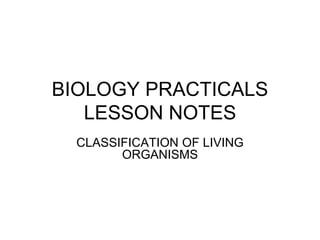Biology practicals lesson notes
This document provides an overview of biology practical lessons on classifying living organisms. It begins by introducing classification as the science of systematically grouping organisms based on similarities and differences in both external and internal anatomy, as well as genetics and evolution. Organisms are classified into taxa and five main kingdoms are identified: Monera, Protista, Fungi, Plantae, and Animalia. Details are then given on the Animalia kingdom, including its defining characteristics of being multicellular, heterotrophic organisms with tissues, nerves, and the ability to move. Animals are further divided into those with or without a notochord. Examples of phyla within the Animalia kingdom are provided, with more in-depth details given

Recommended
More Related Content
What's hot
What's hot (20)
Similar to Biology practicals lesson notes
Similar to Biology practicals lesson notes (20)
More from MabulaPaul
More from MabulaPaul (7)
Recently uploaded
Recently uploaded (20)
Biology practicals lesson notes
- 1. BIOLOGY PRACTICALS LESSON NOTES CLASSIFICATION OF LIVING ORGANISMS
- 2. WELLCOME TO THE LESSON. • Hi • Its my hope that you are fine and ready to discover new knowledge hidden in the study of life and living organisms. Under this lesson you'll acquire knowledge and skills to apply on classification practical questions which appears in the national exams and in our daily life at large.
- 3. CLASSIFICATION OF LIVING ORGANISMS Classification- is the science that deals with the systematic way of placing organism in groups (taxa) basing on the similarities and differences. The similarity and different features are includes INTERNAL and EXTERNAL ANATOMY.
- 4. • Physiological functions, GENETICAL make up and evolutionary relationship (history) • Taxa are categories that are used to deferent organisms • A specific taxa that organisms belong is called a taxon • The taxa are normally arranged in descending order from kingdom to species.
- 5. Cont… • In modern classification, scientist grouped all living things into five kingdoms as follows:- • Kingdom monera • Kingdom protista • Kingdom fungi • Kingdom plantae • Kingdom animalia
- 6. KINGDOM ANIMALIA. • The word animal comes from a Latin word means HAVING BREATH. • The kingdom animalia is composed of animals which vary greatly in structure, morphology and the way their body factions.
- 7. GENERAL CHARACTERISTICS OF ANIMAL. • All animals are multicultural organisms. • Animal bodies are differentiated into tissues. • All animals are heterotrophs. • They store carbohydrate in form of glycogen. • They exercise locomotion. • All animals are eukaryotic.
- 8. DISTINCTIVE FEATURES OF ANIMALS. • The cell of animals have only bounded by a plasma membrane. • They have a nervous system that are capable of detecting changes at the environment.
- 9. Cont… • Animals can be grouped into groups on their bases of presences or absences of a notochord. • Those without notochord are called non- chordates. • Those with notochord are called chordates.
- 10. Cont… • A notochord is a supporting rod like structure running longitudinally along the dorsal side of the animal and it can persist throughout of the life or may be replaced by a back borne. • The kingdom animalia is categorized into phyla which includes:-
- 11. Cont… • Phylum platyhelminthes. • Phylum nematoda (aschelminthes). • Phylum annelida. • Phylum arthropoda. • Phylum chordata.
- 12. PHYLUM PLATYHELMINTHES. Platyhelminthes means flat worms, they get their name from their flat bodies. They inhibit fresh water, salt water and terrestrial habitats. Some members are free living while others are parasitic. Platyhelminthes has three classes these are tubelaria, trematoda and cestoda.
- 13. GENERAL FEATURES. 1. They are bilaterally symmetrical. 2. they have soft epidemic with cilia or covered with articles. 3. Their bodies are usually dorsal ventrally flattened. 4. They are triploblastic with no body cavity or coelom. 5. They have no skeletal, respiratory, and circulatory system. 6. Their nervous system has a pair of arterial ganglia or nerve ring.
- 14. DISTINCTIVE FEATURES. 1. They have soft unsegmented bodies. 2. Their digestive system is incomplete, that is the digestive cavity has only a single opening which is a mouth, there is no anus, except in class cestoda. 3. Their usually hermaphrodites. Hermaphrodites are organisms with both male and female sex organs.
- 15. planaria
- 16. planaria
- 17. planaria
- 18. planaria
- 19. planaria
- 20. Distinctive characteristics. 1.They are aquatic living in fresh water. 2.They are outer surface is covered with cilia. This help them to move in water and glide over the surface of stones. 3.They have only mouth, no anus. Therefore, the undigested food leaves the body by the same opening it enters. 4.They are hermaphrodite but usually undergo cross fertilization. 5.They can reproduce asexually by spiriting into two halves each of which will generate into complete organisms.
- 21. End of first post To be continued…… You can reach us on whatsapp +255742731295 We care you
Editor's Notes
- 6